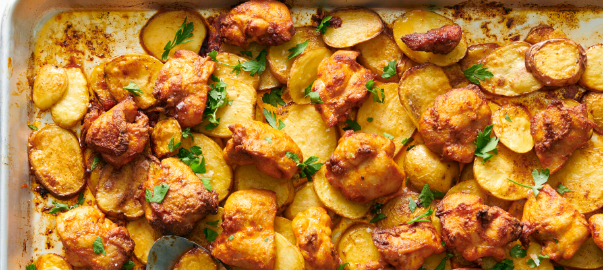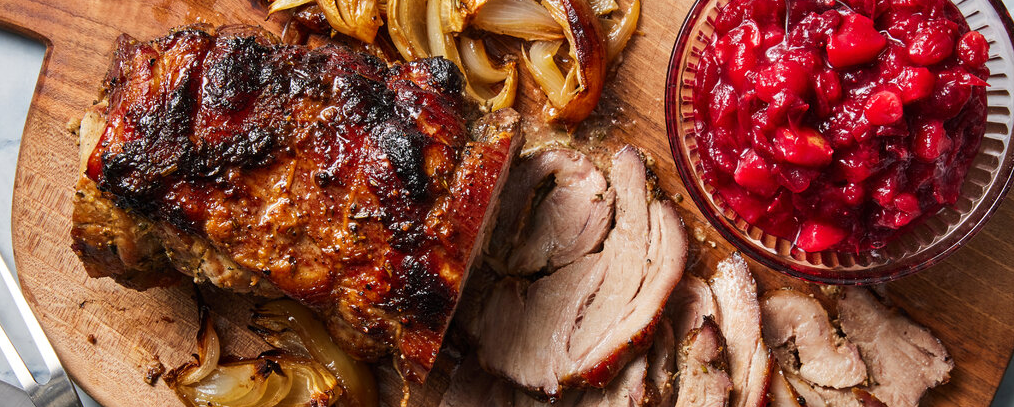Cook a Pork Loin on the Grill
How to Cook a Pork Loin on the Grill: Internal Temperature, Cooking Time, and Marinade Tips

Pork loin is one of the most forgiving and flavorful cuts to prepare on the grill. Unlike pork tenderloin, which is smaller and leaner, pork loin is larger and allows for more control over temperature and flavor. As a chef, I often choose pork loin for events and dinner parties because it provides beautiful slices, takes on marinades well, and serves a crowd. Grilling enhances its flavor by adding smoke and caramelization without drying it out—if you follow the proper steps.
- Ingredients and Tools You’ll Need
- How to Grill a Pork Loin: Step-by-Step
- Grilling Temperature and Doneness Table
- Oven Method: Alternative to Grilling
- Stovetop + Oven Finish
- Pressure Cooker Option
- Microwave? Only for Reheating
- Sauce and Marinade Ideas
- Flavor Variations That Always Work
- How to Slice and Plate for Maximum Appeal
- Storage and Reheating Tips to Keep It Juicy
- What to Serve with Grilled Pork Loin
- Leftover Ideas: Transforming Pork Loin into New Meals
- How to Plate Pork Loin Like a Pro
- Pork Loin for Special Occasions: My Elevated Approach
- My Final Thoughts: Why This Recipe Works Every Time
- FAQ: 15 Chef-Backed Answers

Ingredients and Tools You’ll Need
Ingredients:
- 2–3 lb boneless pork loin
- Salt, pepper
- Olive oil or neutral oil
- Optional: garlic powder, mustard powder, smoked paprika, fresh herbs
- Marinade or dry rub
- Glaze or sauce for finishing
Equipment:
- Gas or charcoal grill with lid
- Instant-read thermometer
- Tongs
- Small bowl for marinade or glaze
- Aluminum foil for resting
These items create a professional setup at home.
Preparing Pork Loin for Grilling: Marinade or Dry Rub
When preparing pork loin, I decide whether to use a marinade or a dry rub depending on the time available and the flavor goal. If I’m using a marinade, I combine acidic ingredients like lemon juice or vinegar with oil, herbs, garlic, and a sweetener such as honey or maple syrup. I let the pork sit in the marinade for four to twelve hours in the refrigerator. If I opt for a dry rub, I use a blend of salt, pepper, and aromatic spices, applying it liberally and letting it rest at room temperature for up to an hour. Either method sets the foundation for a flavorful and juicy result.

How to Grill a Pork Loin: Step-by-Step
Grilling pork loin properly is all about heat control and patience. I begin by preheating the grill to a steady medium-high temperature. I create a two-zone heat setup by keeping one side of the grill hot for searing and the other side cooler for slow roasting. Once the grill is ready, I sear the pork loin on all sides to build a flavorful crust. Then I transfer it to the cooler side, close the lid, and allow it to cook through slowly. When the internal temperature reaches 130°F, I begin applying glaze in thin layers. I remove the loin from the grill at 140–145°F and let it rest under foil for 10–15 minutes to ensure juicy slices.
Grilling Temperature and Doneness Table
Cooking pork loin to the right internal temperature is critical for flavor and safety. I find that pulling the loin off the grill at 140°F results in slightly pink, incredibly juicy meat. After resting, the temperature rises to the USDA-recommended 145°F. Going above 150°F usually leads to drier texture, while anything below 140°F risks undercooking. In my experience, grilling to medium doneness is the perfect balance between flavor and safety.
Oven Method: Alternative to Grilling
When grilling isn’t an option, I roast pork loin in the oven. I set the oven to 375°F, place the loin on a rack inside a roasting dish, and cook uncovered. I baste with glaze during the last 10–15 minutes, removing the meat once it reaches 140–145°F. I still let it rest afterward, just like I do on the grill. Though it lacks the smokiness of a grill, it produces a beautifully cooked, evenly browned pork loin with minimal fuss.

Stovetop + Oven Finish
If I’m working with a smaller pork loin, I sometimes use the stove-to-oven method. I begin by searing all sides of the pork in a hot, oven-safe skillet to develop a crust. Then I transfer the skillet to a preheated 350°F oven to finish cooking. This method gives me excellent browning and control over the cooking process, especially when preparing pork loin indoors.
Pressure Cooker Option
For faster preparation, I use the pressure cooker. I first sear the pork using the sauté function, then add broth or a marinade base and seal the lid. Cooking on high pressure for 20 minutes, followed by a 10-minute natural release, yields a very tender pork loin. To add texture, I often broil or pan-sear the cooked meat just before serving.
Microwave? Only for Reheating
Microwaving raw pork loin is not something I recommend. However, for reheating leftovers, it can be useful. I slice the meat, place it in a dish with a bit of broth or sauce, cover it with a damp paper towel, and reheat at reduced power. I’ve found that microwaving on 50% power in short intervals helps avoid overcooking and preserves moisture.
Avoid These Common Mistakes
There are a few key pitfalls that can sabotage grilled pork loin. Overcooking is the most common—once the meat goes beyond 150°F, it dries out rapidly. Another mistake is skipping the resting period, which causes the juices to escape when slicing. Starting with a cold pork loin straight from the fridge leads to uneven cooking, with the outside done before the inside has warmed. Applying sugary sauces too early during grilling can lead to burning instead of caramelization. I always wait until the final 10–15 minutes before brushing on any glaze.
Sauce and Marinade Ideas
Over the years, I’ve crafted a variety of sauces and marinades that enhance pork without overpowering its natural flavor. Lemon-herb combinations offer a bright, clean taste. Maple-mustard blends are perfect for autumn meals. Soy-ginger mixtures create rich umami flavor ideal for fusion dishes. Apple and bourbon glazes bring sweetness and depth, especially when finished on the grill. Each of these options complements pork’s mild, slightly sweet profile
Flavor Variations That Always Work
One of the great joys of cooking pork loin is how well it absorbs global flavor profiles. I’ve personally tested countless variations in both home and professional kitchens, and some have become signature offerings. A Mediterranean-inspired pork loin benefits from the herbal depth of oregano, garlic, lemon zest, and olive oil. I often pair this with roasted vegetables and a light yogurt-based sauce.
For a Caribbean twist, I use warm spices like allspice, nutmeg, and fresh thyme combined with lime juice and chilies. This combination produces a rich, aromatic crust and works beautifully with grilled pineapple or coconut rice.
Asian-inspired versions are also incredibly successful. I marinate the pork in soy sauce, sesame oil, garlic, ginger, and rice vinegar, then finish with a sticky hoisin glaze. The balance of sweetness, salt, and umami is irresistible and pairs well with pickled vegetables and rice.
When I want comfort food, I lean into American-style flavors—using a smoky dry rub and brushing with apple cider BBQ sauce toward the end. No matter the direction I take, the pork loin acts as a reliable canvas, letting the seasonings shine.

How to Slice and Plate for Maximum Appeal
Slicing pork loin properly is crucial for both texture and presentation. I always slice across the grain, at a slight angle, into medallions about a quarter to half an inch thick. This keeps each bite tender and helps the meat maintain structure on the plate. The first few slices, slightly fanned outward, already create a professional impression.
For plating, I consider the final image the guest sees. I arrange the pork slices atop a base of mashed vegetables or grains, such as polenta or farro, placing them slightly off-center for a more dynamic layout. I drizzle sauce around the meat instead of over it, preserving the surface glaze or char.
A final garnish—perhaps fresh herbs, citrus zest, or a thin stream of infused oil—adds visual appeal and freshness. Whether serving a rustic family dinner or a formal meal, intentional slicing and plating elevate the entire dish.
Storage and Reheating Tips to Keep It Juicy
After investing time in cooking pork loin perfectly, preserving its texture through proper storage and reheating is essential. Once the pork has finished resting and cooled slightly—usually within 30 to 45 minutes after serving—I store it promptly to avoid moisture loss or bacterial growth. I slice the meat before storing, as this makes reheating faster and more even. Each slice goes into an airtight container, and I always spoon in some of the leftover glaze or pan sauce to maintain moisture.
In the refrigerator, the pork loin keeps its quality for up to four days. For longer storage, I wrap the slices in plastic wrap, then foil, and finally place them into a labeled freezer bag. In my experience, this triple-layer approach preserves flavor and prevents freezer burn for up to three months.
When it’s time to reheat, I avoid aggressive heat. My preferred method is using the oven. I place the sliced pork into a baking dish with a splash of broth or sauce, cover it tightly with foil, and heat it at 300°F (150°C) for about 15–20 minutes. This allows gentle, even warming. If I’m in a rush, I reheat on the stovetop in a nonstick skillet with a tablespoon of water, covered and on low heat. For microwaving—which I use only if absolutely necessary—I slice the pork thin, cover it with a damp paper towel, and use 50% power in 30-second bursts. The key is always to warm, not recook.
What to Serve with Grilled Pork Loin
As a chef, I always look at a dish not in isolation but as part of a complete plate. Pork loin, being mild and slightly sweet, pairs beautifully with a range of sides. But not every pairing works equally well. To me, the ideal accompaniments combine softness and freshness, acidity and texture.
For something comforting, I serve pork loin with creamy mashed potatoes or velvety polenta. These starches provide a soft contrast to the firmer meat and absorb sauces well. When I want something more refined, I use couscous, barley, or farro, often tossed in herbs or lemon zest.
Vegetables matter just as much. I roast carrots, Brussels sprouts, or asparagus until caramelized, then finish them with a squeeze of lemon juice or balsamic glaze. This touch of acidity balances the pork’s richness and keeps the meal lively.
Greens are essential for color and brightness. A simple arugula salad with shaved fennel and citrus vinaigrette is one of my favorite pairings. I’ve also served pork loin with apple and cabbage slaw or grilled peaches when I want a sweeter counterpoint. The best side dish doesn’t compete—it complements.

Leftover Ideas: Transforming Pork Loin into New Meals
Leftovers aren’t just practical—they’re a creative opportunity. When I cook pork loin, I often prepare extra on purpose because I know the next-day possibilities are so rewarding.
For lunch, I slice the cold pork thin and layer it into sandwiches with Dijon mustard, arugula, and pickled red onions on sourdough. The balance of richness, bite, and acidity makes a meal that feels thoughtful and complete. Another go-to of mine is tacos: I reheat shredded pork gently and pile it into warm tortillas with cabbage slaw, avocado, and lime crema.
For dinner, I often cube the pork and toss it into fried rice or a stir-fry with vegetables and sesame-ginger sauce. The pre-cooked pork cuts down on prep time, and the result is just as satisfying as the original meal. I also use leftover slices in pasta—either with a light garlic and olive oil base or a creamy mustard sauce.
Even soups and stews can benefit from leftover pork. I dice the meat and add it toward the end of cooking to preserve its texture. It works beautifully in lentil soups, vegetable broths, or even chili. The secret is to see the pork not as a leftover, but as an ingredient that’s already 90% ready.
How to Plate Pork Loin Like a Pro
Presentation matters. I’ve seen it time and time again—even the simplest dishes feel elevated when plated with intention. For pork loin, I begin by slicing the rested roast into even medallions, about ¼ inch thick. I slice on a slight diagonal and always across the grain. This creates tender pieces that look uniform and professional.
Next, I decide on the layout. If I’m going rustic, I lay the slices directly on a wooden board or a warm serving platter, overlapping them slightly. For a plated presentation, I’ll fan three to five slices across the plate, usually slightly offset from center. I avoid crowding. There should always be space for the eye to rest.
When adding sauce or glaze, I never pour it over the top. Instead, I drizzle it around or beside the meat so that the glaze acts as a visual accent rather than hiding the sear or crust. I garnish sparingly—just a few fresh herb leaves, a thin lemon twist, or a small scoop of chutney or puree.
Serving is the final act of cooking. The way you present the pork tells your guest, visually, that what they’re about to eat was made with care.
Pork Loin for Special Occasions: My Elevated Approach
When I cook pork loin for special gatherings—be it a holiday meal, dinner party, or private client event—I take several extra steps to elevate the dish. First, I choose a larger roast, usually three to four pounds, which not only feeds more people but also retains moisture better. I often use a dry-brining technique: I season the meat with salt and aromatics 24 hours in advance and leave it uncovered in the fridge. This process enhances flavor and helps develop a beautiful crust on the grill.
Sometimes, I butterfly the loin and stuff it with ingredients like sautéed spinach, roasted red peppers, and herbed goat cheese. After rolling and tying it securely, I grill it gently over indirect heat and baste with a glaze in the final 15 minutes. This adds drama and flavor to every slice.
For an impressive finish, I brush the resting pork with a thin coat of honey-balsamic glaze. I slice it cleanly and serve it on a warmed platter, fanning the pieces in an arc. A simple garnish of microgreens or pickled shallots adds color and elegance. With just a few refined touches, a humble pork loin becomes a centerpiece.
My Final Thoughts: Why This Recipe Works Every Time
Over the years, I’ve grilled dozens—if not hundreds—of pork loins. What makes this method work so reliably is the balance of control and flexibility. You control the heat, use a thermometer for precision, and apply the glaze when it matters. But you can also adapt the seasoning, the sauce, and the style to match any occasion.
Grilled pork loin is the kind of dish that makes a home cook feel like a chef. It’s approachable yet impressive, familiar yet endlessly customizable. When you treat each step with care—from preparation to resting to slicing—you don’t just make a meal. You craft a memorable experience.
FAQ: 15 Chef-Backed Answers
Do I need to brine pork loin before grilling?
I’ve brined pork loins overnight and found they stay juicier. Not essential, but I recommend it if you have time.
How do I keep it from drying out?
Use a thermometer and remove at 140–145°F. Let it rest. I also suggest not trimming all fat.
Can I cook pork loin directly over the flame?
I sear over direct heat but finish over indirect. Full direct cooking will likely burn the outside.
Is marinating overnight too long?
Only if the marinade is highly acidic. I usually marinate for 6–8 hours. I’ve done overnight without issue using oil-based marinades.
What’s the best wood for smoking pork loin?
I prefer apple or cherry wood—they’re mild and fruity. Hickory is stronger and works too.
Can I grill a stuffed pork loin?
Yes, I’ve done this for events. Just use butcher’s twine and monitor the center temp carefully.
What happens if I slice it too soon?
The juices will run out, and the pork dries quickly. Rest at least 10 minutes—I’ve made this mistake myself early on.
Should I trim the silver skin?
Yes. I always remove any silver skin—it doesn’t break down and makes the texture tough.
What’s the difference between loin and tenderloin?
Loin is wider and ideal for grilling whole. Tenderloin is smaller, thinner, and cooks faster. Don’t confuse them.
Can I glaze and grill at the same time?
Yes, but only in the last 10–15 minutes. Earlier, and you’ll risk burning due to sugars.
How can I tell if it’s fully cooked without a thermometer?
Thermometers are ideal, but you can press the meat—it should feel firm but still yield slightly. Clear juices are another sign. Still, I always recommend using a thermometer.
What side sauces pair best with pork loin?
I’ve had great results with mustard sauces, apple chutney, and fruit-based glazes. Acid + sweetness is my formula.
Can I use the leftovers in soup?
Yes. I cube the pork and add it to bean soups, stews, or ramen. Adds depth and richness.
Should I butterfly the pork loin?
Only if stuffing it. Otherwise, I keep it whole to ensure even doneness and better juiciness.
What’s the easiest beginner-friendly marinade?
Olive oil, lemon juice, garlic, salt, and rosemary. I’ve used this hundreds of times—it’s fast, clean, and always works.



Post Comment